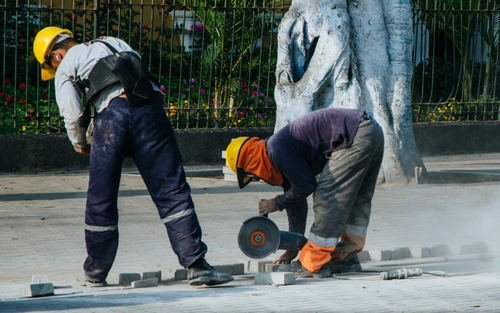Silica Dust Rules and Regulations
Working in manufacturing or construction industries means being exposed to a number of respiratory hazards, including silica dust. Respirable crystalline silica is commonly found in these job sites as a natural consequence of the activities that are usually done there: cutting, grinding, drilling, brushing stone, concrete, brick, mortar, drywall, and other construction materials can all create silica dust.
Silica dust is a direct and serious threat to the respiratory health and safety of anyone who’s near it. Without proper protection, these tiny particles can get into workers’ lungs and cause lung disease, known as silicosis. Crystalline silica can also cause lung cancer, chronic obstructive pulmonary disease, and kidney disease, even years after exposure. It can also cause shortness of breath, chest pains, and difficulty breathing. Exposure or potential exposure to silica dust requires workers to wear respirators specially made to protect against these contaminants. Follow this guide on the latest rules, regulations, and best practices on protecting employees from silica dust.
OSHA Silica Dust Regulations
OSHA requires that all businesses keep workers safe but has stringent requirements for those businesses and industries where respirable crystalline silica is a common hazard.
OSHA updated its safety requirements for silica dust back in 2016. This ruling set a new permissible exposure limit (PEL) for respirable crystalline silica: 50 micrograms per cubic meter of air over the course of an 8-hour shift. If your workplace surpasses OSHA’s PEL for silica dust, protection needs to be offered.
Employers are also required to monitor the work environment for potential exposure to silica dust. Taking accurate readings requires the use of personal sampling pumps fitted to each employee to give you an accurate representation of the amount of dust in the breathing zone (the area around someone’s nose and mouth). Worksites will need to be tested every three to six months to see if there’s a change in silica dust levels over time. If you are unable to do this work, professional industrial hygienists are available on a consulting basis to collect and analyze atmospheric samples for you to ensure that you’re staying in compliance with the most up-to-date OSHA standards.
You’ll also need to have engineering controls in place to control the level of silica dust in the air. Water spray systems, ventilation, and other such systems can help limit worker exposure to the respirable crystalline silica PEL. Where possible, worker access to especially high-risk areas should be limited. Administrative controls like developing a written exposure plan, keeping safety requirements posted throughout the workspace where workers can see them, and training workers on silica risks and ways to reduce exposure are also required. Finally, employers should also provide PPE, such as respirators, when engineering; administrative controls alone aren’t enough to limit exposure.
Because certain industries have a higher risk of high exposure than others, employers also need to support workers’ ability to get healthcare for the effects of respirable crystalline silica exposure. Employers need to support and provide means for exposed workers to obtain medical exams they help monitor their respiratory health.
Respiratory Protection for Silica
For protection from silica dust, a respirator is the way to go. The silica dust respirator you choose should have a NIOSH rating of N95 or higher, such as P100. N95 filters will capture 95% of dust particles, including those from silica, but only as long as it fits properly so that the air you breathe is filtered.
Most respirators come with an adjustable strap for ensuring a proper fit, and all workers should have access to safety equipment that fits. Proper fit is especially important where respirable crystalline silica is a concern. When buying your masks, purchase a variety of sizes and styles so that team members have options. N95 and other masks are available in a variety of styles, from disposable two-strap “dust mask” respirators to a half mask with replaceable filters, and all the way up to a full-face respirator. Some sizes and styles will be too large or small for some workers, which makes it to your advantage to provide a variety of sizes for different workers. Workers who have facial hair should take extra care when choosing their respirators because facial hair can prevent a tight seal. These workers should wear a PAPR type respirator with a hood.
Respirators should be as lightweight and compact as possible to avoid being distracting or too uncomfortable to wear—respirators with exhalation valves are great for this because they can keep workers cool and comfortable with an increased exchange of fresh air.
Simply providing the masks and ensuring that they fit properly isn’t going to be enough. Employers must take the initiative to ensure that the equipment you provide is maintained, repaired, and replaced as needed. Keep respirators in a secure location when they aren’t being used, and make sure fresh filters are readily available.
If you have more questions about protection for respirable crystalline silica or other safety equipment and practices, PK Safety can help. We provide dozens of quality respirators and filters that we would personally trust to keep us safe on the job. Our website and blog has valuable information and are always available. For personalized recommendations from a safety expert, reach out with our online contact form or by calling 800.829.9580.
A respirator mask works only as good as it fits. It won’t protect you from hazards if it doesn’t fit your face properly.
LEARN HOW TO SIZE A RESPIRATOR
Recent Posts
-
Customizing Gas Detectors: Tailoring Solutions to Fit Your Unique Requirements
In today’s diverse industrial landscape, a one-size-fits-all approach to safety simply doesn’t cu …Jul 3rd 2024 -
10 Ways to Prevent Wildfires
You can prevent wildfires by extinguishing flames before you leave the worksite. Avoid practicing …Jul 1st 2024 -
ANSI/ISEA 138 Safety Gloves: Ensuring Hand Protection
The human hand is an anatomical masterpiece and arguably the greatest tool attached to our bodies …Jun 25th 2024





